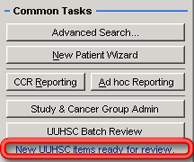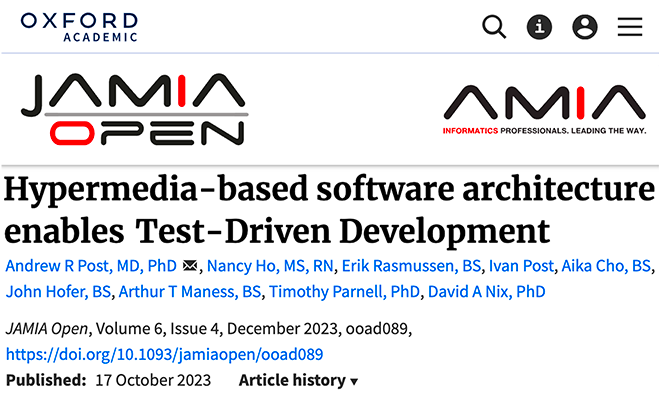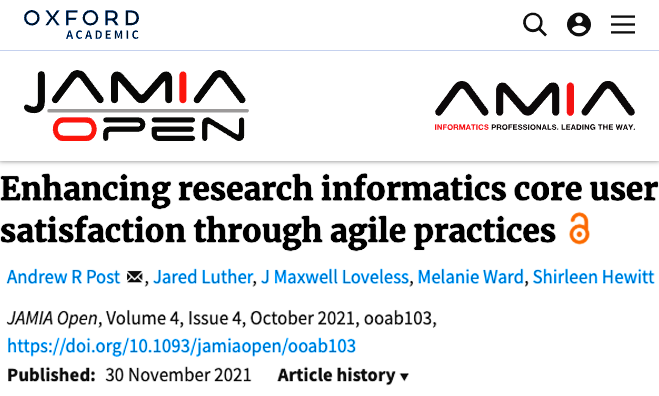- Welcome
- Features
- Use Case
- Introduction
- Working with CCR
- Basic navigation and usage tips
-
Working with patients
- Working with patients
- Searching for a patient
- Looking up a patient with an MRN
- Using the Quick Search Utility to search for a patient
- Performing an advanced search
- Performing a search with criteria based on study or cancer group specific attributes
- Restrictions on searches
- Adding a patient
- Adding a patient who has never been a UUHSC patient
- Removing a patient record from a cancer group database
- Viewing/editing a patient record
- Marking a patient record ready for review
- Viewing/editing the demographic information of a patient who has never been a UUHSC patient
- Viewing a patient's clinic visit patient review page
- Providers
- Treatment protocols
- Diagnoses and staging
- Tumors
- Race
- Patient classifications
- Aliases
- Cancer group studies administration
- Patient contacts
-
Studies and study enrollment
- Studies
- Viewing/editing study-specific data for a patient
- Viewing/editing a patient's enrollment in a study
- Study enrollment
- Enrolling a patient in a study
- Removing a patient from a study
- Viewing/editing a patient's enrollment in a study from the patient detail window
- Patient consents
- Patient consents (study enrollment window)
- Recording a patient consents
- Recording a patient consents (study enrollment window)
- Deleting a patient consent record
- Deleting a patient consent record (study enrollment window)
- Editing a patient consent record
- Editing a patient consent record (study enrollment window)
- Scanned consent forms
- Scanned consent forms (study enrollment window)
- Uploading a scanned consent form
- Uploading a scanned consent form (study enrollment window)
- Removing a scanned consent form
- Removing a scanned consent form (study enrollment window)
- Viewing a previously uploaded consent form
- Viewing a previously uploaded consent form (study enrollment window)
-
Specimens
- Specimens
- Adding a specimen to a patient record
- Linking a specimen from itBioPath to a patient record
- Removing a specimen from a patient record
- Viewing/editing a specimen in a patient record
- Accessing a specimen's itBioPath record
- Recording an alias for a specimen
- Deleting a specimen alias
- Editing a specimen alias
- Linking a previously unlinked specimen to an itBioPath record
- Specimens associated with a medical event
- Linking a medical event to an existing specimen in the patient record
- Adding a specimen to a medical event
- Linking a specimen from itBioPath to a medical event
- Removing a specimen from a medical event
- Viewing/editing a specimen that is associated with a medical event
-
Lab tests
- Lab tests
- Setting up a lab test type to be automatically imported into the patient records of a cancer group
- Adding lab rest results to a patient record
- Reviewing a patient's UUHSC lab test records for importing into CCR
- Deleting a lab test result from a patient record
- Viewing/editing a lab test result
- Lab tests associated with a medical event
- Adding lab test results to a medical event
- Linking a medical event to a previously entered lab test result record
- Adding a lab test result to a medical event and a patient record at the same time
- Removing a lab test result from a medical event
- Viewing/editing a lab test result that is associated with a medical event
-
Medical events
- Medical events
- Adding a medical event to a patient record
- Removing a medical event to a patient record
- Viewing/editing a medical event
- Tools to facilitate medical event data entry
- Associated medical events
- Associating a medical event with other medical events
- Removing a medical event's association with another medical event
- CPT codes
- Adding a CPT code to a medical event
- Removing a CPT code to a medical event
- Medical event classification
- Assigning a classification to a medical event
- Removing a classification from a medical event
-
Chemo and systemic therapy events
- Chemo and systemic therapy events
- Therapy agents
- Entering the default agents for a specific therapy regimen
- Adding a therapy agent to a chemotherapy medical event record
- Removing a therapy agent from a chemotherapy medical event record
- Resetting therapy agents and dosages to match the default values for a selected regimen
- Editing a therapy agent record in a chemotherapy medical event
- Chemotherapy adverse events
- Adding an adverse event record to a chemotherapy medical event
- Removing an adverse event record to a chemotherapy medical event
- Editing an adverse event in a chemotherapy medical event
-
Radiation therapy events
- Radiation therapy events
- Treatment summaries
- Adding a radiation therapy sequence to a radiation therapy medical event
- Deleting a radiation therapy sequence to a radiation therapy medical event
- Editing a radiation therapy sequence in a radiation therapy medical event
- Radiation therapy adverse events
- Adding an adverse event record to a radiation therapy medical event
- Deleting an adverse event record from a radiation therapy medical event
- Editing an adverse event record for a radiation therapy medical event
-
Imaging events
- Imaging events
- Images
- Adding an image to an imaging event
- Uploading an image from an imaging event
- Adding an image to an imaging event without uploading it
- Viewing an image from an imaging event
- Deleting an image from an imaging event
- Editing the description of an image
- Findings
- Adding a finding from an imaging event
- Deleting a finding from an imaging event
- Editing a finding from an imaging event
-
Enterprise data warehouse and tumor registry records
- ITS Enterprise Data Warehouse
- Linking an encounter (medical event) from the Enterprise Data Warehouse to a patient record
- Linking a previously unlinked medical event record to an EDW encounter
- Importing a lab test result from the EDW into a medical event and a patient record at the same time
- Performing a text search of EDW records using keywords associated with a medical event type
- Performing a text search of EDW records using keywords associated with pathology reports
- Performing a text search in an EDW report using a keyword that has not been automatically generated
- Refining the list of EDW reports included in a text search
- Reviewing a patient's UUHSC encounter and clinical records for medical events to add to their CCR record
- Viewing a patient's EDW records
- Viewing a patient's EDW records from within a pathology report record
- Viewing the details of a UUHSC clinical record
- Finding a UUHSC encounter for a patient in EDW
- Viewing a patient's tumor registry records
- Viewing the details of a UUHSC encounter
-
Pathology reports
- Pathology reports
- Adding a pathology report to a medical event
- Linking an existing pathology report to a medical event
- Adding a new (not previously existing) pathology report to a medical event
- Removing a pathology report from a medical event
- Viewing/editing a pathology report
- Tools to facilitate pathology report data entry
-
Using the Patient Review Summary page
- Adding a treatment protocol to a patient record from the patient review page
- Diagnoses and staging from the patient review page
- Diagnoses
- Adding a diagnosis to a patient record from the patient review page
- Deleting a diagnosis to a patient record from the patient review page
- Editing a patient's diagnosis from the patient review page
- Staging
- Adding staging information to a diagnosis
- Deleting staging information from a diagnosis
- Editing Staging Information
- Worklists
- Reports
-
Cancer group administration
- Cancer group administration
- Starting the Cancer Group Administration
- Cancer Group Medical Events Administration
- Adding a Medical Event Type to the List of Medical Event Types of Interest to a Cancer Group
- Removing a Medical Event Type from the List of Medical Event Types of Interest to a Cancer Group
- Editing a Cancer Group Medical Event Type
- Making an Event Type Inactive
- Activating an Inactive Event Type
- Associating a Medical Event Type with a Specific Study
- Removing a Medical Event Type Study Association
- Sharing a Medical Event Type with Another Cancer Group
- Ending the Sharing of a Medical Event Type with a Specific Cancer Group
- Using an Event Type Owned and Shared by Another Cancer Group
- Ceasing the Use of an Event Type Owned and Shared by Another Cancer Group
- Adding a Standard of Care Profile
- Deleting a Standard of Care Profile
- Standard of Care Profiles
- Editing a Standard of Care Profile
- Adding a Checklist Item to a Standard of Care Profile
- Patient Education Materials
- Adding a Patient Education Packet to a Standard of Care Profile
- Removing a Checklist Item from a Standard of Care Profile
- Removing a Patient Education Packet from a Standard of Care Profile
- Viewing the Contents List of a Patient Education Packet
- Auto Generated Events
- Adding an Auto Generated Event to a Standard of Care Profile
- Removing an Auto Generated Event from a Standard of Care Profile
- Editing an Auto Generated Event in a Standard of Care Profile
- The Metabuilder
- Security
- Administering cancer group users
- Administering users — study-based roles
- Dictionaries
On the left side of the CCR desktop is the Quick Access Toolbar. This toolbar is permanently anchored to that part of the desktop and cannot be moved, resized, minimized or closed. You also cannot move any of CCR's windows so that they cover any part of the toolbar. It will always be readily accessible so that you can quickly use any of its features, regardless of how many windows are open on the CCR desktop.

At the top of the toolbar is a boxed section that displays the current user and session purpose information. Included is the name of the current user, and the cancer Group, the Site the user is associated with , the session Purpose and Study (if applicable) entered when you first logged on to the application.
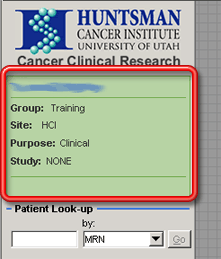
If your current session purpose and/or user security roles restrict you from viewing identifying data (or from using fields that hold identifying data as the basis of search criteria), this will be indicated in the session information box at the top of the CCR Quick Access Toolbar with the words Data De-Identified in red letters at the bottom of that box beneath the Cancer Group, Session Purpose and Study. The search criteria fields based on identifying data on the CCR Quick Access Toolbar will also be grayed out and deactivated.
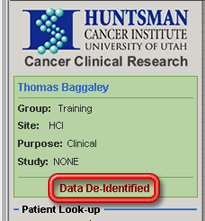
Below this, the toolbar is divided into three sections:
First is the Patient Look-up area which is used for looking up a patient by their MRN or HCI Person ID — see Looking Up a Patient with an MRN.

Next comes the Patient Quick Search area, which is used for searching for patients based the most common kinds of criteria including: Last Name, First Name (you may enter only part of a name in which case all patients whose names start with the indicated characters and meet all other specified criteria will be returned), patients whose first visit to the clinic for the cancer group occurred during a specific range of dates (a pair of date fields labeled First Visit), patients whose records include a medical event of a specified type (Medical Event Type), patients that have assigned a specific Patient Classification, or patients who have been diagnosed at some point as being at a certain Stage of cancer (whether that was the result of initial diagnosis staging or a later status update, regardless of whether this was the most recent staging event).
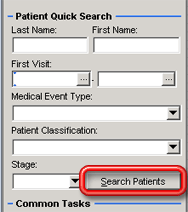
See Using the Quick Search Utility to Search for a Patient for more information on how to use this area of the Quick Access Toolbar. Buttons (labelled Go and Search Patients) are provided in each area to initiate the corresponding search once the criteria has been entered.

In order for a patient record to be displayed as a result of your search, it must meet ALL of your specified search criteria. CCR's search capabilities do not include using more complicated hierarchical inclusion and exclusion logic structures.
The bottom area of the Quick Access Toolbar has a series of buttons for performing Common Tasks.

Some of the buttons in this area may be grayed out, meaning they are not available for use. Which buttons will be available and functional depends on your session purpose and specific user security roles — see Security in CCR.
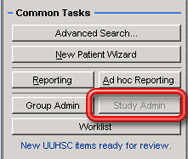
The Advanced Search… button opens the Advanced Patient Search window, allowing you to perform a search among the patient records with criteria based on any of the fields in the patient record, not just the more common ones available in the Patient Quick Search area — see Performing an Advanced Patient Search for detailed instructions on how to do this and The Advanced Patient Search Window for a description of the possible criteria fields on the window.

The New Patient Wizard button opens the New Patient Wizard window, which allows you to add a new patient to your cancer group, accessing that patient's information from the EDW — see Adding a Patient and The New Patient Wizard.
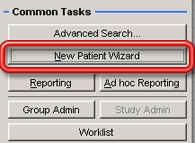
The Reporting button opens the Global Reports module, giving access to CCR's pre-formatted global reports — see Standard Reports.
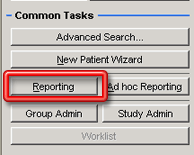
The iQ Reporting button starts the iQ tool — see iQ Reports.
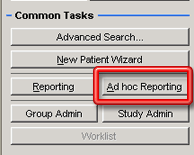
The Group Admin button opens the CCR Administration window for your cancer group, which is used to maintain the list of studies within the cancer group, assign cancer group and study-based security roles to database users and maintain the list of medical events associated with the cancer group — see Cancer Group Administration.
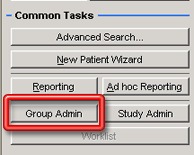
The Study Admin button opens the Study Editor window for the study for the current study, allowing you to administer the settings of that particular study. In order to access this button, you must have Research/Study for a specific study selected as your session purpose.
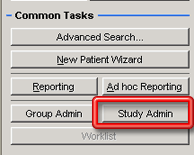
The Worklist button opens the [Cancer Group] — Worklist window, which has several features that help to catch patients and data that need to be entered into CCR — see Worklists.
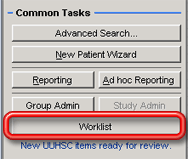
If there are encounters for patients in the cancer group to be reviewed, the words New UUHSC items ready for review. will appear beneath the button in blue letters.
